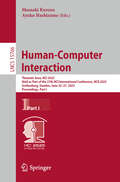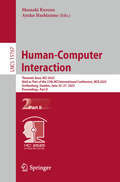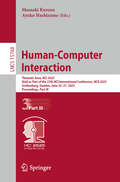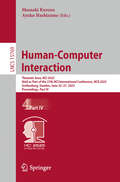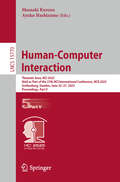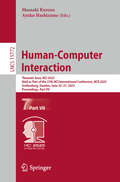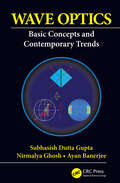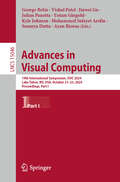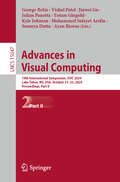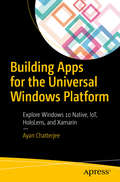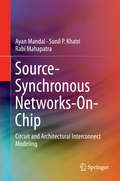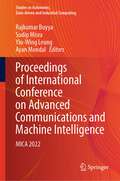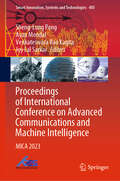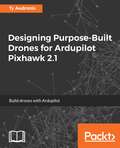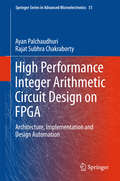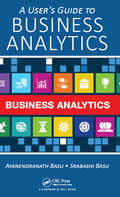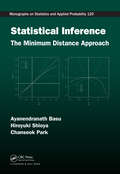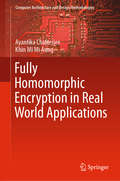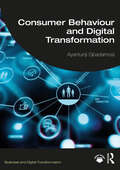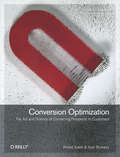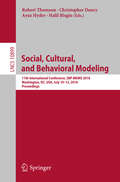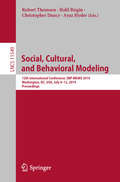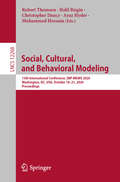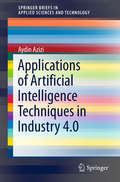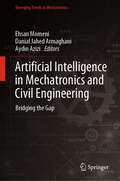- Table View
- List View
Human-Computer Interaction: Thematic Area, HCI 2025, Held as Part of the 27th HCI International Conference, HCII 2025, Gothenburg, Sweden, June 22–27, 2025, Proceedings, Part I (Lecture Notes in Computer Science #15766)
by Masaaki Kurosu Ayako HashizumeThis seven-volume set constitutes the refereed proceedings of the Human Computer Interaction thematic area of the 27th International Conference on Human-Computer Interaction, HCII 2025, held in Gothenburg, Sweden, during June 22–27, 2025. The HCI Thematic Area constitutes a forum for scientific research and addressing challenging and innovative topics in Human-Computer Interaction theory, methodology and practice, including, for example, novel theoretical approaches to interaction, novel user interface concepts and technologies, novel interaction devices, UI development methods, environments and tools, multimodal user interfaces, emotions in HCI, aesthetic issues, HCI and children, evaluation methods and tools, and many others.
Human-Computer Interaction: Thematic Area, HCI 2025, Held as Part of the 27th HCI International Conference, HCII 2025, Gothenburg, Sweden, June 22–27, 2025, Proceedings, Part II (Lecture Notes in Computer Science #15767)
by Masaaki Kurosu Ayako HashizumeThis seven-volume set constitutes the refereed proceedings of the Human Computer Interaction thematic area of the 27th International Conference on Human-Computer Interaction, HCII 2025, held in Gothenburg, Sweden, during June 22–27, 2025. The HCI Thematic Area constitutes a forum for scientific research and addressing challenging and innovative topics in Human-Computer Interaction theory, methodology and practice, including, for example, novel theoretical approaches to interaction, novel user interface concepts and technologies, novel interaction devices, UI development methods, environments and tools, multimodal user interfaces, emotions in HCI, aesthetic issues, HCI and children, evaluation methods and tools, and many others.
Human-Computer Interaction: Thematic Area, HCI 2025, Held as Part of the 27th HCI International Conference, HCII 2025, Gothenburg, Sweden, June 22–27, 2025, Proceedings, Part III (Lecture Notes in Computer Science #15768)
by Masaaki Kurosu Ayako HashizumeThis seven-volume set constitutes the refereed proceedings of the Human Computer Interaction thematic area of the 27th International Conference on Human-Computer Interaction, HCII 2025, held in Gothenburg, Sweden, during June 22–27, 2025. The HCI Thematic Area constitutes a forum for scientific research and addressing challenging and innovative topics in Human-Computer Interaction theory, methodology and practice, including, for example, novel theoretical approaches to interaction, novel user interface concepts and technologies, novel interaction devices, UI development methods, environments and tools, multimodal user interfaces, emotions in HCI, aesthetic issues, HCI and children, evaluation methods and tools, and many others.
Human-Computer Interaction: Thematic Area, HCI 2025, Held as Part of the 27th HCI International Conference, HCII 2025, Gothenburg, Sweden, June 22–27, 2025, Proceedings, Part IV (Lecture Notes in Computer Science #15769)
by Masaaki Kurosu Ayako HashizumeThis seven-volume set constitutes the refereed proceedings of the Human Computer Interaction thematic area of the 27th International Conference on Human-Computer Interaction, HCII 2025, held in Gothenburg, Sweden, during June 22–27, 2025. The HCI Thematic Area constitutes a forum for scientific research and addressing challenging and innovative topics in Human-Computer Interaction theory, methodology and practice, including, for example, novel theoretical approaches to interaction, novel user interface concepts and technologies, novel interaction devices, UI development methods, environments and tools, multimodal user interfaces, emotions in HCI, aesthetic issues, HCI and children, evaluation methods and tools, and many others.
Human-Computer Interaction: Thematic Area, HCI 2025, Held as Part of the 27th HCI International Conference, HCII 2025, Gothenburg, Sweden, June 22–27, 2025, Proceedings, Part V (Lecture Notes in Computer Science #15770)
by Masaaki Kurosu Ayako HashizumeThis seven-volume set constitutes the refereed proceedings of the Human Computer Interaction thematic area of the 27th International Conference on Human-Computer Interaction, HCII 2025, held in Gothenburg, Sweden, during June 22–27, 2025. The HCI Thematic Area constitutes a forum for scientific research and addressing challenging and innovative topics in Human-Computer Interaction theory, methodology and practice, including, for example, novel theoretical approaches to interaction, novel user interface concepts and technologies, novel interaction devices, UI development methods, environments and tools, multimodal user interfaces, emotions in HCI, aesthetic issues, HCI and children, evaluation methods and tools, and many others.
Human-Computer Interaction: Thematic Area, HCI 2025, Held as Part of the 27th HCI International Conference, HCII 2025, Gothenburg, Sweden, June 22–27, 2025, Proceedings, Part VII (Lecture Notes in Computer Science #15772)
by Masaaki Kurosu Ayako HashizumeThis seven-volume set constitutes the refereed proceedings of the Human Computer Interaction thematic area of the 27th International Conference on Human-Computer Interaction, HCII 2025, held in Gothenburg, Sweden, during June 22–27, 2025. The HCI Thematic Area constitutes a forum for scientific research and addressing challenging and innovative topics in Human-Computer Interaction theory, methodology and practice, including, for example, novel theoretical approaches to interaction, novel user interface concepts and technologies, novel interaction devices, UI development methods, environments and tools, multimodal user interfaces, emotions in HCI, aesthetic issues, HCI and children, evaluation methods and tools, and many others.
Wave Optics: Basic Concepts and Contemporary Trends
by Subhasish Dutta Gupta Nirmalya Ghosh Ayan BanerjeeThis book combines classical optics with some of the latest developments in the field to provide an appreciation and understanding of advanced research topics. Requiring only a basic knowledge of electromagnetic theory and mathematics, the text covers the fundamentals of wave optics, focusing on concepts related to advances in negative materials and superresolution, reflectionless potentials, plasmonics, spin-orbit interaction, optical tweezers, Pendry lensing, and more. The book includes MATLAB codes for specific research problems and draws parallels with corresponding quantum problems whenever possible to broaden the horizon.
Advances in Visual Computing: 19th International Symposium, ISVC 2024, Lake Tahoe, NV, USA, October 21–23, 2024, Proceedings, Part I (Lecture Notes in Computer Science #15046)
by George Bebis Vishal Patel Kyle Johnsen Jinwei Gu Julian Panetta Yotam Gingold Mohammed Safayet Arefin Soumya Dutta Ayan BiswasThis two-volume set LNCS 15046 and 15047 constitutes the refereed proceedings of the 17th International Symposium, ISVC 2024, held at Lake Tahoe, NV, USA, during October 21-23, 2024. The 54 full papers and 12 poster papers were carefully reviewed and selected from 120 submissions. A total of 8 papers were also accepted for oral presentation in special tracks from 15 submissions. The papers cover the following topical sections: Part I: Deep Learning; Computer Graphics; Video Analysis and Event Recognition; Motion and Tracking; Detection and Recognition; Visualization, and Medical Image Analysis. Part II: Segmentation; Recognition; Generalization in Visual Machine Learning; Vision and Robotics for Agriculture; Virtual Reality; Applications, and Poster.
Advances in Visual Computing: 19th International Symposium, ISVC 2024, Lake Tahoe, NV, USA, October 21–23, 2024, Proceedings, Part II (Lecture Notes in Computer Science #15047)
by George Bebis Vishal Patel Kyle Johnsen Jinwei Gu Julian Panetta Yotam Gingold Mohammed Safayet Arefin Soumya Dutta Ayan BiswasThis two-volume set LNCS 15046 and 15047 constitutes the refereed proceedings of the 17th International Symposium, ISVC 2024, held at Lake Tahoe, NV, USA, during October 21-23, 2024. The 54 (60) full papers and 12 poster papers were carefully reviewed and selected from 120 submissions. A total of 8 (13) papers were also accepted for oral presentation in special tracks from 15 submissions. The papers cover the following topical sections: Part I: Deep Learning; Computer Graphics; Video Analysis and Event Recognition; Motion and Tracking; Detection and Recognition; Visualization, and Medical Image Analysis. Part II: Segmentation; Recognition; Generalization in Visual Machine Learning; Vision and Robotics for Agriculture; Virtual Reality; Applications, and Poster.
Building Apps for the Universal Windows Platform: Explore Windows 10 Native, IoT, HoloLens, and Xamarin
by Ayan ChatterjeeDevelop Windows 10 applications faster and more efficiently using the Universal Windows Platform. You will use Xamarin to create apps for macOS, iOS, and Android devices. Building Apps for the Universal Windows Platform is a complete guide covering PCs, tablets, phones, and other devices such as HoloLens. You will use Windows 10 to develop apps for desktop, mobile, holographic, wearable, and IoT devices. You will reuse code to easily create cross-platform apps. What You Will Learn Design and develop apps using Visual Studio and Blend Create Cortana-enabled apps for a hands-free experience Build IoT apps and apps for wearables such as the Microsoft HoloLens Monitor apps post-publication to gain insights from actionable data using Windows Store Analytics and Azure Who This Book Is For Professional developers working independently or in a team on Windows 10 applications, and students coming into the world of software development
Source-Synchronous Networks-On-Chip
by Sunil P. Khatri Ayan Mandal Rabi MahapatraThis book describes novel methods for network-on-chip (NoC) design, using source-synchronous high-speed resonant clocks. The authors discuss NoCs from the bottom up, providing circuit level details, before providing architectural simulations. As a result, readers will get a complete picture of how a NoC can be designed and optimized. Using the methods described in this book, readers are enabled to design NoCs that are 5X better than existing approaches in terms of latency and throughput and can also sustain a significantly greater amount of traffic.
Proceedings of International Conference on Advanced Communications and Machine Intelligence: MICA 2022 (Studies in Autonomic, Data-driven and Industrial Computing)
by Sudip Misra Rajkumar Buyya Yiu-Wing Leung Ayan MondalThis book presents high-quality, peer-reviewed papers from International Conference on Advanced Communications and Machine Intelligence (MICA 2022), organised by M.Kumarasamy College of Engineering, Chennai, Tamil Nadu, India, during 9–11 December 2022. The book includes all areas of advanced communications and machine intelligence. The topics covered are network performance analysis, data mining and warehousing, parallel and distributed networks, computational intelligence, smart city applications, big data analytics, Internet of Things networks, information management and wireless sensor networks. The book is useful for academicians, scientists, researchers from industry, research scholars and students working in these areas.
Proceedings of International Conference on Advanced Communications and Machine Intelligence: MICA 2023 (Smart Innovation, Systems and Technologies #405)
by Sheng-Lung Peng Ayan Mondal Venkateswara Rao Kagita Joy Lal SarkarThis book presents high-quality, peer-reviewed papers from International Conference on Advanced Communications and Machine Intelligence (MICA 2023), hosted by National Institute of Technology Warangal, Telangana, India, during 30–31 October 2023. The book includes all areas of advanced communications and machine intelligence. The book is useful for academicians, scientists, researchers from industry, research scholars, and students working in these areas.
Designing Purpose-Built Drones for Ardupilot Pixhawk 2.1: Build drones with Ardupilot
by Ty Audronis Lucas De Marchi Ayan Pahwa Ersin GonulKey Features Explore the best practices used by the top industry professionals that will not only help you build drones in time, but also build effective solutions to cater to. Navigate through the complexities of Ardupilot to put together a complete functional UAV and assemble your drone Learn through practical examples that help you build robust UAV flight and ground control components Book Description The Ardupilot platform is an application ecosystem that encompasses various OS projects for drone programming, flight control, and advanced functionalities.The Ardupilot platform supports many Comms and APIs, such as DroneKit, ROS, and MAVLink. It unites OS drone projects to provide a common codebase. With the help of this book, you will have the satisfaction of building a drone from scratch and exploring its many recreational uses (aerial photography, playing, aerial surveillance, and so on). This book helps individuals and communities build powerful UAVs for both personal and commercial purposes. You will learn to unleash the Ardupilot technology for building, monitoring, and controlling your drones.This is a step-by-step guide covering practical examples and instructions for assembling a drone, building ground control unit using microcontrollers, QgroundControl, and MissionPlanner. You can further build robotic applications on your drone utilizing critical software libraries and tools from the ROS framework. With the help of DroneKit and MAVLink (for reliable communication), you can customize applications via cloud and mobile to interact with your UAV. What you will learn Kitbash "dumb" objects into smart ones Program Pixhawk for your drones Fabricate your own parts out of different materials Integrate Pixhawk into different types of drones Build and understand the significant difference between land, sea, and air drones Adapt old Pixhawk sensors to the new Pixhawk 2.1 plugs Become familiar with procedures for testing your new drones
High Performance Integer Arithmetic Circuit Design on FPGA
by Ayan Palchaudhuri Rajat Subhra ChakrabortyThis book describes the optimized implementations of several arithmetic datapath, controlpath and pseudorandom sequence generator circuits for realization of high performance arithmetic circuits targeted towards a specific family of the high-end Field Programmable Gate Arrays (FPGAs). It explores regular, modular, cascadable and bit-sliced architectures of these circuits, by directly instantiating the target FPGA-specific primitives in the HDL. Every proposed architecture is justified with detailed mathematical analyses. Simultaneously, constrained placement of the circuit building blocks is performed, by placing the logically related hardware primitives in close proximity to one another by supplying relevant placement constraints in the Xilinx proprietary "User Constraints File". The book covers the implementation of a GUI-based CAD tool named FlexiCore integrated with the Xilinx Integrated Software Environment (ISE) for design automation of platform-specific high-performance arithmetic circuits from user-level specifications. This tool has been used to implement the proposed circuits, as well as hardware implementations of integer arithmetic algorithms where several of the proposed circuits are used as building blocks. Implementation results demonstrate higher performance and superior operand-width scalability for the proposed circuits, with respect to implementations derived through other existing approaches. This book will prove useful to researchers, students and professionals engaged in the domain of FPGA circuit optimization and implementation.
A User's Guide to Business Analytics
by Ayanendranath Basu Srabashi BasuA User's Guide to Business Analytics provides a comprehensive discussion of statistical methods useful to the business analyst. Methods are developed from a fairly basic level to accommodate readers who have limited training in the theory of statistics. A substantial number of case studies and numerical illustrations using the R-software package are provided for the benefit of motivated beginners who want to get a head start in analytics as well as for experts on the job who will benefit by using this text as a reference book. The book is comprised of 12 chapters. The first chapter focuses on business analytics, along with its emergence and application, and sets up a context for the whole book. The next three chapters introduce R and provide a comprehensive discussion on descriptive analytics, including numerical data summarization and visual analytics. Chapters five through seven discuss set theory, definitions and counting rules, probability, random variables, and probability distributions, with a number of business scenario examples. These chapters lay down the foundation for predictive analytics and model building. Chapter eight deals with statistical inference and discusses the most common testing procedures. Chapters nine through twelve deal entirely with predictive analytics. The chapter on regression is quite extensive, dealing with model development and model complexity from a user’s perspective. A short chapter on tree-based methods puts forth the main application areas succinctly. The chapter on data mining is a good introduction to the most common machine learning algorithms. The last chapter highlights the role of different time series models in analytics. In all the chapters, the authors showcase a number of examples and case studies and provide guidelines to users in the analytics field.
Statistical Inference: The Minimum Distance Approach (Chapman & Hall/CRC Monographs on Statistics and Applied Probability)
by Ayanendranath Basu Hiroyuki Shioya Chanseok ParkIn many ways, estimation by an appropriate minimum distance method is one of the most natural ideas in statistics. However, there are many different ways of constructing an appropriate distance between the data and the model: the scope of study referred to by "Minimum Distance Estimation" is literally huge. Filling a statistical resource gap, Stati
Fully Homomorphic Encryption in Real World Applications (Computer Architecture and Design Methodologies)
by Ayantika Chatterjee Khin Mi AungThis book explores the latest developments in fully homomorphic encryption (FHE), an effective means of performing arbitrary operations on encrypted data before storing it in the ‘cloud’. The book begins by addressing perennial problems like sorting and searching through FHE data, followed by a detailed discussion of the basic components of any algorithm and adapting them to handle FHE data. In turn, the book focuses on algorithms in both non-recursive and recursive versions and discusses their realizations and challenges while operating in the FHE domain on existing unencrypted processors. It highlights potential complications and proposes solutions for encrypted database design with complex queries, including the basic design details of an encrypted processor architecture to support FHE operations in real-world applications.
Consumer Behaviour and Digital Transformation (Business and Digital Transformation)
by Ayantunji GbadamosiThis comprehensive textbook explores how technological developments and emerging technologies impact on, and engage with, consumer behaviour and decision making globally. The book will enable readers to develop a coherent understanding of the basic underpinnings of consumer behaviour as they relate to individual and group-oriented consumption decisions, offering insight into how consumer behaviour, contemporary real-life situations, and digital technology are inextricably linked.Key learning objectives, exercises and activities, boxed examples and analytical frameworks facilitate and enrich students’ learning. Each chapter includes ‘pause, plan, and practice (PPP)’ activities, as well as real-life case studies exploring digital consumption, digital consumer experiences, and digital trends across industries, from global companies such as Nike and McDonald’s to the digital transformation of SMEs. Combining a thorough examination of traditional theory with a fresh approach to the impact of digital transformation on consumer behaviour, this textbook should be core reading for advanced undergraduate and postgraduate students studying Consumer Behaviour, Consumer Psychology, Customer Experience Management, and Digital Marketing.This book will be accompanied by online resources for the use of instructors, including PowerPoint slides and a test bank.
Conversion Optimization: The Art and Science of Converting Prospects to Customers
by Khalid Saleh Ayat ShukairyHow do you turn website visitors into customers?Conversion Optimization offers practical advice on how to persuade visitors to make a buying decision -- without driving them away through data overload or tedious navigation. You'll learn how to use marketing principles, design, usability, and analytics on your site to increase your buyer-to-visitor ratio, whether you're involved with marketing or designing a large ecommerce site, or managing a modest online operation.Based on the authors' broad experience in helping businesses attract online customers, this book addresses every aspect of the process, from landing visitors to finalizing the sale. You'll learn several techniques for blending successful sales approaches with the particular needs of the people you want to attract. Are you ready to do what it takes to get a double-digit conversion rate?Explore case studies involving significant conversion rate improvementsWalk through different stages of a sale and understand the value of eachUnderstand your website visitors through persona creationConnect with potential customers and guide them toward a conversionLearn how to deal with FUDs -- customer fears, uncertainties, and doubtsExamine the path that visitors take from landing page to checkoutTest any change you make against your original design"The Web is unique in its ability to deliver this almost improbable win-win: You can increase revenue AND make your customers happy. Yet most websites stink. Worry not, Khalid and Ayat to the rescue! Buy this book to follow their practical advice on how to create high converting websites that your visitors love."--Avinash Kaushik, author of Web Analytics 2.0 and Web Analytics: An Hour A Day (both Sybex)
Social, Cultural, and Behavioral Modeling: 11th International Conference, SBP-BRiMS 2018, Washington, DC, USA, July 10-13, 2018, Proceedings (Lecture Notes in Computer Science #10899)
by Robert Thomson Christopher Dancy Ayaz Hyder Halil BisginThis book constitutes the proceedings of the 11th International Conference on Social, Cultural, and Behavioral Modeling, SBP-BRiMS 2018, held in Washington, DC, USA, in July 2018. The total of 27 short and 18 full papers presented in this volume was carefully reviewed and selected from 85 submissions. The contributions were organized in topical sections named: advances in sociocultural and behavioral process modeling; information, systems, and network science; applications for health and well-being; military and intelligence applications; cybersecurity.
Social, Cultural, and Behavioral Modeling: 12th International Conference, SBP-BRiMS 2019, Washington, DC, USA, July 9–12, 2019, Proceedings (Lecture Notes in Computer Science #11549)
by Robert Thomson Christopher Dancy Ayaz Hyder Halil BisginThis book constitutes the proceedings of the 12th International Conference on Social, Cultural, and Behavioral Modeling, SBP-BRiMS 2019, held in Washington, DC, USA, in July 2019. The total of 28 papers presented in this volume was carefully reviewed and selected from 72 submissions. The papers in this volume show, people, theories, methods and data from a wide number of disciplines including computer science, psychology, sociology, communication science, public health, bioinformatics, political science, and organizational science. Numerous types of computational methods are used include, but not limited to, machine learning, language technology, social network analysis and visualization, agent-based simulation, and statistics.
Social, Cultural, and Behavioral Modeling: 13th International Conference, SBP-BRiMS 2020, Washington, DC, USA, October 18–21, 2020, Proceedings (Lecture Notes in Computer Science #12268)
by Robert Thomson Christopher Dancy Ayaz Hyder Halil Bisgin Muhammad HussainThis book constitutes the proceedings of the 13th International Conference on Social, Cultural, and Behavioral Modeling, SBP-BRiMS 2020, which was planned to take place in Washington, DC, USA. Due to the COVID-19 pandemic the conference was held online during October 18–21, 2020. The 33 full papers presented in this volume were carefully reviewed and selected from 66 submissions. A wide number of disciplines are represented including computer science, psychology, sociology, communication science, public health, bioinformatics, political science, and organizational science. Numerous types of computational methods are used, such as machine learning, language technology, social network analysis and visualization, agent-based simulation, and statistics.
Applications of Artificial Intelligence Techniques in Industry 4.0 (SpringerBriefs in Applied Sciences and Technology)
by Aydin AziziThis book is to presents and evaluates a way of modelling and optimizing nonlinear RFID Network Planning (RNP) problems using artificial intelligence techniques. It uses Artificial Neural Network models (ANN) to bind together the computational artificial intelligence algorithm with knowledge representation an efficient artificial intelligence paradigm to model and optimize RFID networks.This effort leads to proposing a novel artificial intelligence algorithm which has been named hybrid artificial intelligence optimization technique to perform optimization of RNP as a hard learning problem. This hybrid optimization technique consists of two different optimization phases. First phase is optimizing RNP by Redundant Antenna Elimination (RAE) algorithm and the second phase which completes RNP optimization process is Ring Probabilistic Logic Neural Networks (RPLNN). The hybrid paradigm is explored using a flexible manufacturing system (FMS) and the results are compared with well-known evolutionary optimization technique namely Genetic Algorithm (GA) to demonstrate the feasibility of the proposed architecture successfully.
Artificial Intelligence in Mechatronics and Civil Engineering: Bridging the Gap (Emerging Trends in Mechatronics)
by Aydin Azizi Danial Jahed Armaghani Ehsan MomeniRecent studies highlight the application of artificial intelligence, machine learning, and simulation techniques in engineering. This book covers the successful implementation of different intelligent techniques in various areas of engineering focusing on common areas between mechatronics and civil engineering. The power of artificial intelligence and machine learning techniques in solving some examples of real-life problems in engineering is highlighted in this book. The implementation process to design the optimum intelligent models is discussed in this book.
